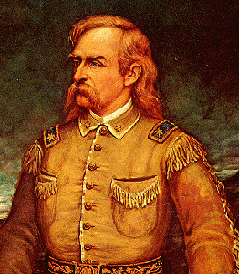|
A Brief Historical
Sketch of
The Order of Indian Wars of the United States

During the spring of 1896, Colonel B.J.D. Irwin, Assistant Surgeon
General,
U.S. Army Retired, gathered together and
organized a group of fellow officers
in Chicago and at Fort
Sheridan all of whom had participated in the Plains Indian
Wars. The purpose of this gathering was to organize “ a
Society that should stand related to
the
Indian Wars of the
United States”. The Society would be called "The Order of
Indian Wars of the United States" (OIWUS) and would use as
its paradigm other extant military lineage sodalities such
as the Society of the Cincinnati (War of Independence), The
Aztec Club of 1847 (Mexican War) and the Military Order of
the Loyal Legion of the United States (Union Army, War
Between the States).
All of these hallowed societies were formed by veteran participants with provisions for
descendants. Ab
initio the Order was to be a society of veteran
officer participants in the Indian Wars and their male
descendants. As with those stated organizations, the
first qualification for any prospective
member of the
Order was that he be a patriotic gentleman of impeccable
character. The second qualification was military service
in any of the myriad conflicts, battles or actual field
service against hostile Indians within the jurisdiction
of the United States. Providentially, the OIWUS also
provided for hereditary male membership. Today the
entire membership is hereditary since the last officer
participants died many decades ago.
The purpose of the
OIWUS was to perpetuate the history of the services rendered by
the American military forces during the various conflicts and
wars within the territory of the United States. Furthermore, the
Order was committed to collecting and publishing historical data
pertaining to “the brave deeds and personal devotion” of those
involved in Indian warfare. The Charter Members of the Order
were: Colonel B.J.D Irwin; Major George W. Baird; Lieutenant
Colonel Ruben F. Bernard; Captain C.H. Conrad; General J.W.
Cloud; Major Forest H. Hathaway; and Captain Allyn Capron. The
OIWUS flourished after the formal chartering of 10 June 1896,
claiming as members a number of renowned military men. General
John J. Pershing; Major General Frederick D. Grant; Brigadier
General Edward J. McClernand; Brigadier General Samuel W.
Fountain; Brigadier General Edward S. Godfrey; Lieutenant
Colonel Ulysses S. Grant III; and Major Charles A. Coolidge were
all members of the OIWUS.
During its first fifty years, the Order had over 300 Original
Companions - participants in the Indian conflicts, over 275
Hereditary Companions and seventy‑five Junior Companions on its
membership rolls. The Order held symposiums and published
several papers, most of which can be referenced in a tome
entitled The Papers of the
Order of The Indian Wars compiled and edited by John M.
Carroll, The Old Army Press, Fort Collins (1975). From 1896
until 1910 the Order met informally and left few minutes of its
meetings and ruefully published none of the comments of its
annual speakers. From 1911 until 1916 minutes only are extant,
then termed The Proceedings of the Order of Indian Wars of
the United States. Nonetheless, from 1917 through 1942, not
only are the minutes published, but arguably of greater value,
the papers presented to the annual meetings by learned
historians and officer event participants were preserved all as
part of the Proceedings. The Order suspended meetings
during World War II as it had during part of World War I. By
1950, almost all of the Original Companions had passed away.
During the early years most of the annual meetings were held at
the Army Navy Club in Washington, D.C. During the years
subsequent to World War II, the annual meetings became informal
luncheon events held either at the Metropolitan Club of
Washington, D.C. or the Cosmos Club of Washington, D.C.
By the mid 1990's,
the Hereditary Companions had dwindled to a handful of loyal but
aging members. However, the membership began to once again
expand with a new generation of historically aware members. The
Order began holding the Annual Meetings in the tradition of the
Original Companions, i.e., black/white tie banquets,
period musical entertainment, humorous remarks, and all quaffed
down with potables, game, and cigars.
We are privileged
to have several current life members who affiliated with the
Order in the 1930s as Junior Members. They are: Brigadier
General Michael J.L. Greene USA (Ret) (Badge No. 639); Brigadier
General Lawrence Vivians Greene USA (Ret) - recently deceased -
(Badge No. 600); and Douglass Greene (Badge No. 674). Brigadier
General Michael Greene is a past Commander of the Order.
The Order
continues to preserve the memory of those soldiers, pioneers and
settlers who were the agents of manifest destiny, and who, with
unyielding bravery and uncommon sacrifice, helped to tame the
New World and build the America that we all cherish beyond
description. Today the OIWUS boasts a membership of nearly 200
Hereditary Companions and is considered to be one of the
premiere lineage societies in the nation. Membership in the
Order is coveted both genealogically and socially, and its
Annual Banquet is recognized as perhaps the most enjoyable and
qualitatively impeccable hereditary society function of any in
existence. Patriam Tuens Civilitatem Ducens.
6 January 2010
Copyright ©
The Order of Indian Wars of the United States
|

